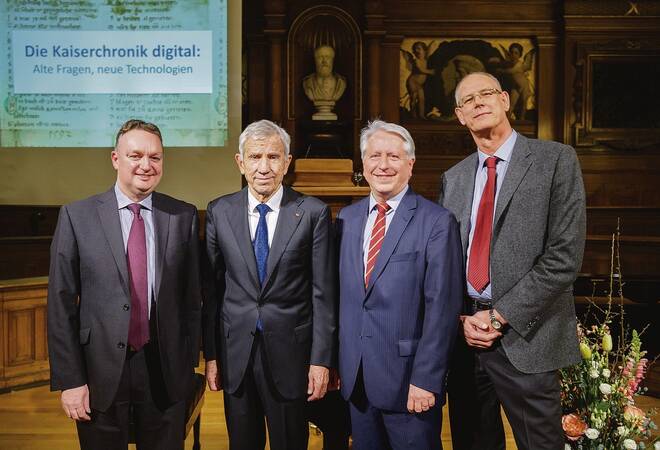The Appian Way is perhaps the world's most celebrated road. On the outskirts of Rome it is a major tourist attraction. I have just discovered you can see some of its far reaches on photographs from space.
The Way seems to be the source of a common misconception in the English-speaking world that all Roman roads were solidly paved and ran straight as a laser, up hill and down dale, never yielding to the lie of the land. Beyond Terracina, much of the
Via Appia was neither paved nor straight, but wriggled along long-worn prehistoric
ridgeway routes, where
the ground was drier (and harder) and the traveler had the best chance
of spotting approaching attackers, whether they were bandits or bears.
Begun under the direction of Appius Claudius, a consul, in 312 BCE, the Via Appia initially connected Rome to Capua near Naples. Later it was extended to Brindisi on the Adriatic Coast. It was any physical traces of this latter extension that I was hoping to find while on a visit last week to Italy.
We were staying in the newly elegant city of Matera which is dolling itself up to be one of two European Capitals of Culture of 2019. In Roman times, Matera was just a remote warren of hand-hewn caves, never mentioned in the ancient sources. Perhaps it was a refuge of the above-mentioned bandits, who could murder a merchant on the Via Appia at dusk and carry the booty 15 kilometers away to the caves to hide it, safely holed up by midnight like the Ahlbergs' brigands:
Near Matera one finds two modern highways named Via Appia. The one beginning from Ferandina, national highway SS7, and proceeding via Matera to Massafra is a fake, although it too terminates at Brindisi. The other, Puglia provincial road SP28, marked "Strada Provinciale Appia" on maps, is, in some stretches at least, the real thing.
Recent articles by Luciano Piepoli dispense with the armchair scholarship (mainly German) about this part of the Via. They assemble new hard archaeological evidence about its course and stage-stops. Unfortunately Piepoli does not provide GIS geolocations (this ought to be prescribed by the style guides of every journal dealing with historical geography). He writes:
The Appian Way, at the exit from the current town of Gravina in Puglia, begins its path in a south-easterly direction near Scomunicata and, after having touched the localities of Graviscella and Ponte Padule Cardena, reaches the rocky outcrop of the Murgia Catena, located about 7 km southeast of Altamura.
The road runs along the southern slope of this last location to Iesce, where there are the remains of an important settlement that had been abandoned by the 2nd century B.C.
On the territory of Altamura, in a flat section between the southern slope of the Murgia Catena and the hillock of Montepovero, the projecting traces of wheel ruts are visible in the rocky surface for a length of about 200m and a total width of more than 30m, forming multiple lanes. Although they are not contemporary with one another, it appears highly probable by virtue of their topographical location that some of them must derive from the consular Via Appia. (My English, helped by Apple and Google Translate).
Hoping to see these traces of the wheels of ancient or medieval carts, we stopped our car on the shoulder of the SP28 at what we thought was the spot. Since a narrow lane of wheat was growing there on the verge of the road itself, we searched the rocky field behind it, but to no avail. On the point of giving up, and after nearly stepping on a sturdy snake, I finally discovered the ruts further up the road.
In the 50-second video above you may hear a cicada and will see the colorful wild flowers of a southern Italian spring including tall fennel, all growing in the dirt that has collected in the ruts.
The most pronounced track is at the left, close to the dry-stone wall. There are no doubt specialists who could estimate from the wheelbase whether this track is ancient or medieval. A second, shorter bunch of tracks can be found about 50m further down the hill (in a 24-second video). I have uploaded videos of both to
my YouTube Channel.
The greatest surprise came later: these ruts are visible on common garden satellite imagery. When I studied the
same location on Google Maps later, I was amazed to see the big set of ruts quite clearly at the location 40.76424, 16.61516 (tip: copy just this to any sat-nav or mapping app to find it):
As far as I know, this remarkable, aerially visible archaeological site is not listed on any of the ancient geographical portals such as the
Digital Atlas of the Roman Empire,
Pelagios or
Vici. I can see how to add it to Vici (and will add it later), but I must admit that I have no idea yet how to contribute it to the former two. They do not offer any "guide for dummies" instructions.
These stone remains are no longer 30 meters wide, since the new road passes through the middle, and they do not seem to have gained any legal protection, although the feature is surely known locally. The IGM map of 1919 (reproduced as British AMS M791 of 1939) labels a nearby stretch of the road "od via antica Via Appia" (I don't know what "od" means).
Piepoli relies on a survey of the area by the great aerial archaeologist of the 1920s to the 1950s, Giuseppe Lugli, so I presume these remains are mentioned in Lugli's books or articles. As far as I can tell, they are the only surface evidence left of the ancient Via Appia between Gravina and Tarento.
The fact that wheels ran across bedrock here is an indication that the highway was unpaved. A few kilometers away, the route has been archaeologically excavated. Piepoli writes:
Near Masseria Capitolicchio Vecchia, recent excavations conducted by the Archaeological Superintendency of Puglia have highlighted a short stretch (about 200 x 4.90 m) of a road - of the glareata type - interpreted, on the basis of the construction technique, orientation and topographic context, as a segment of the Appian Way [Mattioli, 2002]. An interesting fact which emerged during the excavations is that the roadway is partially obliterated by a layer of relative collapse likely due to a structure located near the road axis. The ceramic finds and coins found can be dated between the end of the 2nd century BC and the 3rd century AD, which could be considered as a terminus post quem for the abandonment of the Via Appia in this section.
The simple
glareata road had a base of stones, built up to a sand or gravel surface, and would be kicked or ground apart by heavy traffic if it were not maintained. This is probably what happened at 40.76424, 16.61516, exposing the bedrock to the grinding of cart and carriage wheels. Above, I mentioned a narrow crop of wheat growing in the queen's acre (the roadside). It too is clearly visible in the space imagery, and occupies what seems to have once been a ford through a seasonal stream, the Vulle. No doubt the silt, organic particles and the churning of the wheels created a fertile slough in this rocky landscape which, as the 1919 map shows, travelers had to edge around.
Most of the Via Appia in this area follows the watershed. Here's a more open location, looking towards the Murgia Catena from the north-west, where you may be able to see that the land slopes very lightly away to both sides.
To the left of this spot, the drop to the base of the valley is quite substantial, as the next image shows:
In an article this year, the scholar Tønnes Bekker-Nielsen compares the posterity of this southern
Via Appia built in the 3rd century BCE to the highly engineered Via
Traiana built with cuttings and bridges in the 2nd century CE. The bridges ultimately fell down, whereas the prehistoric footpaths and droving tracks along the watersheds proved indestructible. The self-maintaining character of ridgeway routes even after all their gravel has eroded away is the reason that the Via Appia remained in continuous medieval and modern use and was then resurfaced in the 20th century:
For the Roman traveler, the Via Traiana was a significant improvement. It was shorter, had far fewer inclines and declines and was less vulnerable to snowfall. But despite the many advantages of the Via Traiana, it is the Via Appia which has survived to this day. An estimated 90% of the total length of the Appia is still in use as graveled or asphalt road. Large portions of the Via Traiana, on the other hand, are overgrown and impassable. (My assisted translation from the Danish.)
Bekker-Nielsen, Tønnes. ‘Romerske Veje i Syditalien: Via Appia Og via Traiana’.
Vejhistorie, 2018.
Academia.edu
Piepoli, Luciano. ‘Blera e Sub Lupatia (It. Ant. 121,4-5): Proposte per l'identificazione di due stazioni itinerarie lungo il tratto apulo della via Appia’. In
Statio amoena: Sostare e vivere lungo le strade romane, edited by Patrizia Basso and Enrico Zanini. Oxford: Archaeopress, 2016.
Academia.edu
———. ‘Il percorso della via Appia antica nell'Apulia et Calabria: Stato dell'arte e nuove acquisizioni sul tratto Gravina-Taranto’, in
Vetera Christianorum, 51, 2014, 239-261’.
Academia.edu.




















